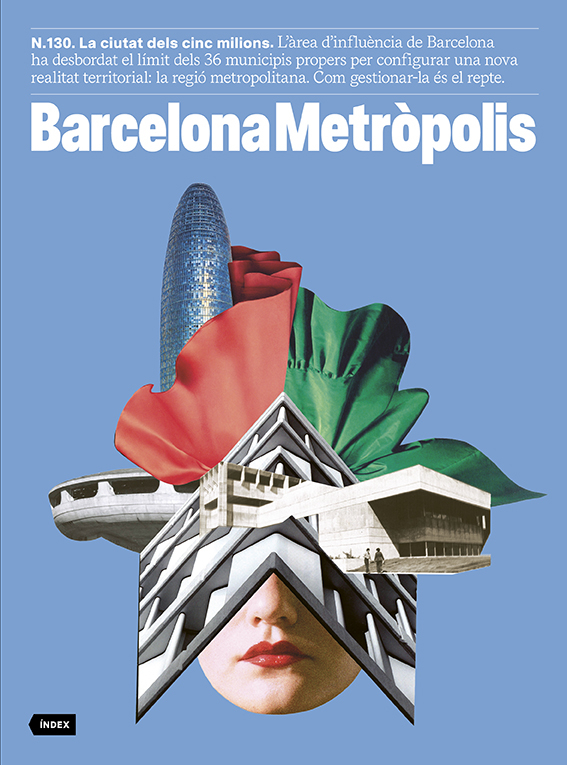What are we talking about when we talk about the metropolitan region?
- Dossier
- Apr 24
- 7 mins
The expansion of urbanisation, coupled with the consequent overflow of administrative boundaries, bears a significant impact on the capacity to govern territories. In Barcelona, the need to address the core urban challenges and to overcome the limitations of administrative fragmentation, is at the heart of the Metropolitan Commitment 2030, the new strategic plan for a city with five million inhabitants.
The 21st century has been dubbed, in various forums, “the century of cities”. This assertion is based on United Nations statistics, which confirm that since 2007, over half of the world’s population has been living in cities and these human conglomerations generate the knowledge and innovation needed to overcome the challenges facing humanity.
However, it’s clear that what we consider a city is hard to encapsulate in a single, unequivocal definition. The Diccionari de la llengua catalana [Dictionary of the Catalan Language] from the Institut d’Estudis Catalans offers two interpretations: a) “A large population that has more pre-eminences than a town”; b) “A large population in contrast to towns, villages and the countryside”. In neither case are we told when this population can be considered large (or whether it is in terms of area or demographics) or what specific pre-eminences characterise it.
Logically, the definitions provided by international organisations or national statistical offices delve deeper into this issue, but what is significant is that the vast majority of these definitions do not align. UN-Habitat, the United Nations agency for cities, has recently had to propose criteria[1] from which states can at least formulate their own classification, as many do not yet have one. It’s important to note, then, that when discussing cities in general, we’re referring to very different entities. Perhaps the main commonality among them is the ongoing interactions between individuals who may not necessarily know each other in their everyday lives within a particular territory.
These interactions can unfold within highly varied contexts, as they are contingent on the territory’s size, level of urbanisation, transportation infrastructure and the volume and distribution of amenities and employment opportunities. Hence, we consider cities such as Houston (2.3 million inhabitants, 1,700 km2 and a density of 1,300 people/km2) as well as Bombay (18 million inhabitants, 603 km2, and of 30,000 people/km2) and Timbuktu (54,000 inhabitants,150 km2 and 360 people/km2).
Today, we also distinguish between the concepts of city and metropolis, often viewing a metropolis as a network of interconnected cities. Nevertheless, this brings into play the common confusion between city and municipality, between the realm of daily interactions and administrative boundaries. A metropolis should be regarded as an expansive and cohesive city encompassing multiple urban centres, regardless of whether they belong to different municipalities. What matters is the functionality of the whole, not the number of municipalities involved.
What is the situation in Catalonia? The challenges in defining cities also affect this matter. For instance, the New Urban Agenda, ratified in Quito in 2016 and serving as a model for countless urban agendas across all levels,[2] has led to the development of an Agenda for “towns and cities”[3] in Catalonia, possibly to avoid further conceptual debates. Yet, this agenda’s technical report explains that “the entire urban network consolidates Catalonia as a predominantly urban country, with a diversity of municipalities of varying demographic sizes and specific functionalities within the overall urban hierarchy.”[4]
The idea of Catalonia as a city has been part of the country’s collective imagination for many years. Currently, Catalonia can be considered a city or metropolis at various territorial and demographic scales, following this progression: one million inhabitants (Barcelona city), three million inhabitants (metropolitan area), five million inhabitants (metropolitan region), and eight million inhabitants (Catalonia). This is due to one of this territory’s distinctive features, arising from, among other factors, its unique industrialisation process – its urban network –, as highlighted by the Agenda.
The metropolitan area and region
When we zoom in on the Barcelona metropolis, we often differentiate between the area and the region, a division underscored by the presence of the institution known as the Metropolitan Area of Barcelona (AMB), comprised of 36 municipalities that predominantly constitute an urban continuum. Nevertheless, urban continuities also extend to municipalities beyond its borders, as seen, for instance, between Barberà del Vallès and Sabadell, or between Montcada i Reixac and La Llagosta.
And that’s how we understand the concept of the metropolitan region here, as the metropolitan territory beyond the AMB. Yet, in functional terms, this distinction does not make much sense because it’s clear that Sabadell or La Llagosta, just like El Masnou or Martorell, and even Granollers or Mataró, partake in the same dynamics as their neighbouring municipalities covered by the metropolitan institution.
Nonetheless, the distinction lies in the territory’s greater complexity, which would still constitute an extensive urban area integrating urban centres, suburbs, infrastructure and various types of sparsely or non-urbanised spaces. Again, in Barcelona, we are talking about over a hundred municipalities, but similar agglomerations elsewhere in the world may have far fewer or even contain this diversity within a single entity. Nonetheless, the fundamental characteristic must also be the presence of significant and daily interactions among the people living throughout this space.
In this regard, delineating Barcelona’s metropolitan reality has been one of the most contentious issues in the development process of the Metropolitan Commitment 2030,[5] recently endorsed by the Barcelona Metropolitan Strategic Plan (PEMB).[6] Some of the reasons that have prompted us to scale up, regardless of the clear continuity, are linked to the evidence arising from demographic dynamics, the distribution of economic activity (primarily industrial), or daily commuting for work. All of these have been thoroughly documented in studies and yearbooks by the Metropolis Institute, among others, as well as in discussions that have led to measures like pandemic-related restrictions or the establishment of low-emission zones.
Finally, in devising the strategy to be implemented within the Metropolitan Commitment 2030, and as a result of negotiations with various cities and territories outside the AMB, the proposal emerged to incorporate both the Barcelona region and the Penedès region (199 municipalities in total)[7] into the process, with a particular emphasis on the municipalities of the Barcelona Metropolitan Arch.[8]
Eight key missions
Eight overarching common goals, called missions, have been set for this extensive territory, covering domains such as housing, cultural vitality, climate emergency response, economic activity, income levels, territorial cohesion, mobility and healthy eating.
These missions each provide an ambitious and transformative goal, shared among a wide range of social and economic stakeholders, looking ahead to 2030. However, it’s important to note that this territory lacks the typical governance tools – a specific government, a budget, legislative or executive powers – and thus, these goals can only be attained through the commitment and collaboration of all stakeholders involved.
The challenge lies in containing within specific boundaries the dynamic phenomena that characterise metropolitan areas.
Therefore, the proposal here is not to establish a new government to oversee this territory, nor to adapt existing ones to a new territorial demarcation. Apart from the political complexities involved in achieving this, the reason lies precisely in the challenge of containing within specific boundaries the dynamic phenomena that characterise metropolitan areas.
Hence, forging alliances among actors (not solely public), developing new tools, data and indicators, and initiating new collaborative processes and goal-oriented work should lead to the development of a bottom-up metropolitan governance. This approach aims to address the major challenges and transitions we face. This is the essence of the Metropolitan Commitment 2030.
References
Font i Llovet, T. and Vilalta Reixach, M. (directors). Anuario del Gobierno Local 2022. El gobierno de las ciudades y de las grandes áreas urbanas. Instituto de Derecho Público – Fundación Democracia y Gobierno Local, Barcelona, 2023.
Metropolis Institute. Anuari Metropolità de Barcelona. Various years. via.bcn/ppZu50Qyb1U
Nel·lo, O. Ciutat de ciutats. Editorial Empúries, Barcelona, 2001.
Ribas i Piera, M. Barcelona i la Catalunya-ciutat. “El fil d’Ariadna” Collection, no. 9. Angle Editorial, Barcelona, 2004.
Tomàs, M. Metrópolis sin gobierno. La anomalía española en Europa. Editorial Tirant lo Blanch, Valencia, 2023.
[1] “What is a city?”: UN-Habitat, 2020. via.bcn/SIIj50QxPuV
“National Sample of Cities”. UN-Habitat, 2020. via.bcn/XJ9150QxPtI
[2] In our case, we draw upon the frameworks provided by the European Urban Agenda (https://www.urbanagenda.urban-initiative.eu) or the Spanish Urban Agenda (https://www.aue.gob.es), along with a dozen local urban agendas, primarily in the province of Barcelona.
[3] The autor inserted the quotation marks.
[4] Memòria tècnica de l’Agenda dels pobles i ciutats Catalunya 2050 [Technical Report of the Catalonia 2050 Towns and Cities Agenda]. Generalitat Government of Catalonia, 2023. via.bcn/9LbP50QyaOS
[5] Barcelona Metropolitan Strategic Plan (PEMB). Compromís Metropolità 2030. Una estratègia per a la ciutat dels cinc milions. Barcelona, 2022.
[6] See https://pemb.cat/ and https://compromismetropolita.cat/ca, along with the platform containing all the documentation generated during the process: via.bcn/N9Cq50QzCiL
[7] Adding to the seven counties of the metropolitan region as defined in the 2010 territorial planning (Alt Penedès, Baix Llobregat, Barcelonès, Garraf, Maresme, Vallès Occidental and Vallès Oriental), we also incorporate the Baix Penedès (in the province of Tarragona) and the municipalities of the Penedès region in the Anoia district.
[8] Associació de Municipis de l’Arc Metropolità de Barcelona [Association of Municipalities in the Barcelona Metropolitan Arch]. arcmetropolitabarcelona.cat/
The newsletter
Subscribe to our newsletter to keep up to date with Barcelona Metròpolis' new developments




